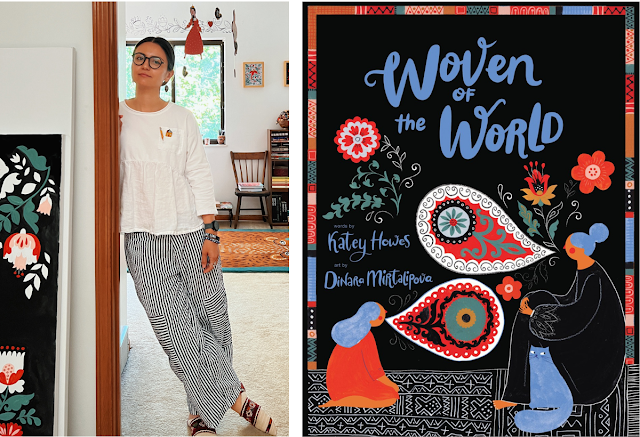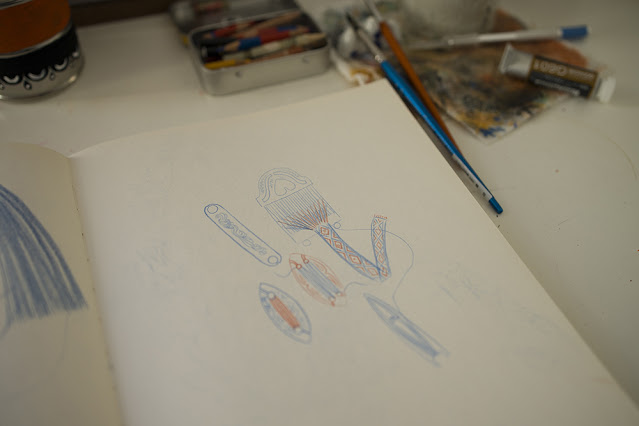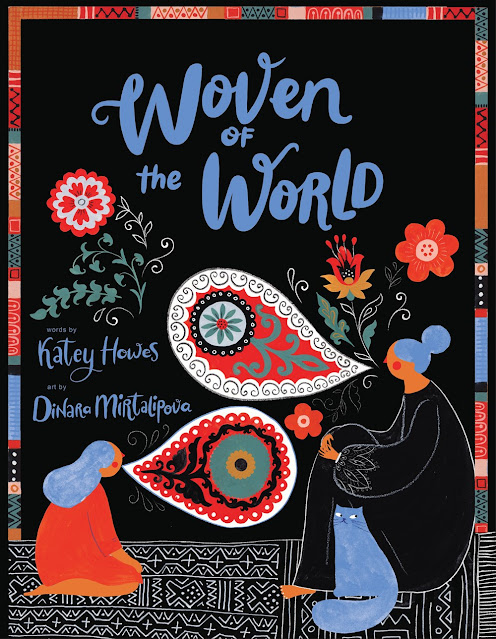Woven of the World by Katey Howes and Dinara Mirtalipova is a beautiful, deeply moving meditation on the interconnectedness of people. I got a chance to talk to Dinara about how she created the illustrations, which do visual justice to the multifaceted tradition of weaving AND just so happen to have been printed with a fifth color (which you know is my jam). I hope you enjoy some insight into this beautifully woven tale!
About the book:
As rhythmic as the swish of a loom, and as vibrant as a skein of brightly dyed wool, this lyrical picture book shares the history and practice of weaving through the centuries and around the world, as imagined by a young weaver learning her craft. Her family's weaving practice helps her feel connected to the past and hopeful for the future. It shows her that each of us is a tapestry: a unique, rich, and beautifully interwoven combination of traits and traditions, with a pattern that is still emerging.
At once a celebration of a time-honored art and a meditation on the ways we are interconnected, this artfully woven narrative gathers the threads of weaving as a technical skill, a cultural tradition, and as a metaphor for how our lives are knit together, into a radiantly intertwined whole.
At once a celebration of a time-honored art and a meditation on the ways we are interconnected, this artfully woven narrative gathers the threads of weaving as a technical skill, a cultural tradition, and as a metaphor for how our lives are knit together, into a radiantly intertwined whole.
Peek underneath the dust jacket:
Let's talk Dinara Mirtalipova!
LTPB: How did you become the illustrator of Woven of the World? What were the first images that popped into your mind when you saw Katey Howes’ text?
When I read the manuscript for Woven of the World sent to me by Chronicle Books for the first time I fell in love with Author Katey Howes’ poetic and lyrical words. Everything about the story connected with me so deeply – the multiculture and interconnectivity, the tapestries, fibers and textiles, and the craft of weaving sampled from various cultures and time periods. Being a folklorist and a textile enthusiast, I loved it all and was excited to dive into illustrating this world together with Katey. I didn’t have a clear vision yet, but I had a yummy flavor for this unique Children’s book, I wanted to find a way to show us - humans as fibers of society, interwoven and deeply connected just like a handmade cloth.
It took me many sketches to define the human characters – the Mother, the Daughter and their silly Cat, who follows them everywhere. If we look at them from the traditional point of character development they appear almost faceless - the challenge I created for myself was to create a cozy relationship of interconnectivity, trust and love without showing their eyes and facial expressions. I wanted to shift the focus from the characters to celebrate weaving instead and to place weaving into the spotlight of the story. In their home every object reminds us of the traditional roots and history of weaving, where it came from, the craft and tradition of weaving becomes the main character of this Children’s book, and human characters are only the vessels.
LTPB: What did you find most difficult in illustrating this book? What did you find most rewarding?
At first, I was too naive to assume the story was about weaving as a craft. I grew up in Central Asia among colorful textiles and stories of Ancient Silk Road, I had a general understanding of the process of weaving. As I rolled up my sleeves and began working on the layout thumbnails and character development, I came to realization that what I knew was not enough. Our local Cuyahoga County Public Library offered a big stack of books on weaving – everything from ancient history to technical books on different types of looms, shuttles, bobbins, heddles and patterns. Some ancient cultures were harder to research or find information on their practice of cloth making and thread spinning – there might have been a little mentioning about the weaving, but usually no images. Being a Folklorist, I personally wanted to find out what was the purpose of some of their textiles, what did they use this meticulously hand-woven cloth for – was it for everyday use, decoration or status? I had so many questions, I had to reach out for help to experts on the subject-matter and historians, who graciously agreed to spare their time and generously provided additional information. I thank them all in my Acknowledgments and any mistakes are my own. The importance and the significance of textiles in the formation of human kind is so grand, it fascinates me how we are similar in one way and so unique at the same time.
LTPB: Can you talk a little bit more about your research process that you allude to in the illustrator note at the back of the book? What are some of the more interesting finds that you were excited to share in the illustrations?
DM: Being a Folklorist I LOVE studying cultures and traditions, doing the research for Woven of the World was my favorite part. There’s a local spinnery here in Cleveland Ohio called Praxis and I took a class there. Local Cuyahoga County Public Library also had a big variety of books. The lovely Editor at Chronicle Books Ariel Richardson sent me a copy of “The Golden Thread: How Fabric Changed History” by Kassia St Clair and this book completely swallowed my attention – it tells story of cloth making and textile industry from ancient caves to the textile and industrial revolution. It made me appreciate the significance of textiles created ages ago and also wonder about the future of textile industry. Besides reading books, I also loved learning so much from wonderful historians and experts and hearing their stories. Debra Sparrow is a native Salish weaver and a knowledge keeper of Salish traditions; Matt Rarey, PhD, an Associate Professor of African and Black Atlantic Art History at Oberlin College; Kristen Windmuller-Luna, PhD, and a lovely Curator of African Art at the Cleveland Museum of Art.
When I read the manuscript for Woven of the World sent to me by Chronicle Books for the first time I fell in love with Author Katey Howes’ poetic and lyrical words. Everything about the story connected with me so deeply – the multiculture and interconnectivity, the tapestries, fibers and textiles, and the craft of weaving sampled from various cultures and time periods. Being a folklorist and a textile enthusiast, I loved it all and was excited to dive into illustrating this world together with Katey. I didn’t have a clear vision yet, but I had a yummy flavor for this unique Children’s book, I wanted to find a way to show us - humans as fibers of society, interwoven and deeply connected just like a handmade cloth.
It took me many sketches to define the human characters – the Mother, the Daughter and their silly Cat, who follows them everywhere. If we look at them from the traditional point of character development they appear almost faceless - the challenge I created for myself was to create a cozy relationship of interconnectivity, trust and love without showing their eyes and facial expressions. I wanted to shift the focus from the characters to celebrate weaving instead and to place weaving into the spotlight of the story. In their home every object reminds us of the traditional roots and history of weaving, where it came from, the craft and tradition of weaving becomes the main character of this Children’s book, and human characters are only the vessels.
LTPB: What did you find most difficult in illustrating this book? What did you find most rewarding?
At first, I was too naive to assume the story was about weaving as a craft. I grew up in Central Asia among colorful textiles and stories of Ancient Silk Road, I had a general understanding of the process of weaving. As I rolled up my sleeves and began working on the layout thumbnails and character development, I came to realization that what I knew was not enough. Our local Cuyahoga County Public Library offered a big stack of books on weaving – everything from ancient history to technical books on different types of looms, shuttles, bobbins, heddles and patterns. Some ancient cultures were harder to research or find information on their practice of cloth making and thread spinning – there might have been a little mentioning about the weaving, but usually no images. Being a Folklorist, I personally wanted to find out what was the purpose of some of their textiles, what did they use this meticulously hand-woven cloth for – was it for everyday use, decoration or status? I had so many questions, I had to reach out for help to experts on the subject-matter and historians, who graciously agreed to spare their time and generously provided additional information. I thank them all in my Acknowledgments and any mistakes are my own. The importance and the significance of textiles in the formation of human kind is so grand, it fascinates me how we are similar in one way and so unique at the same time.
LTPB: Can you talk a little bit more about your research process that you allude to in the illustrator note at the back of the book? What are some of the more interesting finds that you were excited to share in the illustrations?
DM: Being a Folklorist I LOVE studying cultures and traditions, doing the research for Woven of the World was my favorite part. There’s a local spinnery here in Cleveland Ohio called Praxis and I took a class there. Local Cuyahoga County Public Library also had a big variety of books. The lovely Editor at Chronicle Books Ariel Richardson sent me a copy of “The Golden Thread: How Fabric Changed History” by Kassia St Clair and this book completely swallowed my attention – it tells story of cloth making and textile industry from ancient caves to the textile and industrial revolution. It made me appreciate the significance of textiles created ages ago and also wonder about the future of textile industry. Besides reading books, I also loved learning so much from wonderful historians and experts and hearing their stories. Debra Sparrow is a native Salish weaver and a knowledge keeper of Salish traditions; Matt Rarey, PhD, an Associate Professor of African and Black Atlantic Art History at Oberlin College; Kristen Windmuller-Luna, PhD, and a lovely Curator of African Art at the Cleveland Museum of Art.
LTPB: What did you use to create the illustrations in this book? Is this your preferred medium? How does your process change from book to book?
DM: The process of illustration for me always starts by creating pencil sketches to develop the characters and get to know them better. Being a Folk Artist I draw from my heart and I’m not stressed over accuracy of proportions. Those who are familiar with FolkArt will nod, because most Folk Artist don’t have a traditional training in painting, but instead they are known for following their passion and paint regardless of what’s perceived as “correct”. I’m SO glad that the wonderful team at Chronicle Books celebrates that unique approach to illustrating Children’s Books and they are as excited about the books that are stylistically different.
For Woven of the World I envisioned a mom and a daughter, plus their cat who follows them everywhere in the house. I wanted to fill the pages with lots of flowers and patterns and at the same time I wanted to keep the color palette limited. The daughter character at that time felt a lot like my daughter Sabrina – she’s curious, playful and has a deep meaningful relationship with her mom character in the book. Through them I wanted to illustrate that human interactions is very similar to fabrics of our society, how as humans are interwoven through hugs, we exchange thoughts, communication and exchange of ideas. Even the cat character is fully interwoven in interaction with her humans.
I pretty much live in my sketchbooks – it’s my thinking zone and where all the ideas are brewing. They are all random and out of place and reflect my idea development. When I’m possessed with a project the thinking is never off – I tend to get too obsessed with the subject and always need my sketchbook with me to scribble on the thoughts. Once the vision is there I move onto a paper to paint. Gouache is usually my comfort medium. I create most of my illustrations using gouache on paper.
The characters have blue hair (it just felt that way, I don’t have an explanation why), during the process of painting them that beautiful Periwinkle Blue stood out SO much, I felt in love and obsessed over it. In order for the readers to experience this bright blue that you can only see in my original paintings – there’s a process in printing called PMS Fifth Color. It’s a special and expensive form of printing. Most children’s books are created on a budget using digital CMYK color format. To achieve a bright color it requires special PMS ink set up and an extra wiggle in the budget, because it costs more. During our meetings and discussions I advocated on the benefits of using PMS Periwinkle for this book and the wonderful team of Chronicle Books also agreed that the blue should really pop. Now when you open Woven of the World please take a notice of that bright periwinkle blue shade, I hope it’s worth the efforts.
The characters have blue hair (it just felt that way, I don’t have an explanation why), during the process of painting them that beautiful Periwinkle Blue stood out SO much, I felt in love and obsessed over it. In order for the readers to experience this bright blue that you can only see in my original paintings – there’s a process in printing called PMS Fifth Color. It’s a special and expensive form of printing. Most children’s books are created on a budget using digital CMYK color format. To achieve a bright color it requires special PMS ink set up and an extra wiggle in the budget, because it costs more. During our meetings and discussions I advocated on the benefits of using PMS Periwinkle for this book and the wonderful team of Chronicle Books also agreed that the blue should really pop. Now when you open Woven of the World please take a notice of that bright periwinkle blue shade, I hope it’s worth the efforts.
LTPB: Are you working on anything now?
DM: Yes! Just like the characters from Woven of the World, my daughter Sabrina and I are also deeply interwoven – we are collaborating on a fun project where Sabrina is an Author and I’m illustrating. It’s a three pocket-sized books for little kids called North Pole Village. The story portrays a slice of a day at the North Pole and shows three Northern characters - Mr. Klaus, Polar Bear, and Mice. The characters are going through their day, they wake up, they eat breakfast, they are busy at the North Pole doing things and in the evening they go to bed. This project started a few years ago during the pandemic lockdown. Sabrina was in 4th grade and homeschooled at that time she did lots of reading and writing and was into poetry. Today she is in 6th grade and is SO excited to see this book published soon this year!
LTPB: If you got the chance to write your own picture book autobiography, who (dead or alive!) would you want to illustrate it, and why?
DM: I don’t know. I have never thought of writing an autobiography before, so this concept is so new that I feel perplexed even about a possibility.
DM: Yes! Just like the characters from Woven of the World, my daughter Sabrina and I are also deeply interwoven – we are collaborating on a fun project where Sabrina is an Author and I’m illustrating. It’s a three pocket-sized books for little kids called North Pole Village. The story portrays a slice of a day at the North Pole and shows three Northern characters - Mr. Klaus, Polar Bear, and Mice. The characters are going through their day, they wake up, they eat breakfast, they are busy at the North Pole doing things and in the evening they go to bed. This project started a few years ago during the pandemic lockdown. Sabrina was in 4th grade and homeschooled at that time she did lots of reading and writing and was into poetry. Today she is in 6th grade and is SO excited to see this book published soon this year!
LTPB: If you got the chance to write your own picture book autobiography, who (dead or alive!) would you want to illustrate it, and why?
DM: I don’t know. I have never thought of writing an autobiography before, so this concept is so new that I feel perplexed even about a possibility.
Much gratitude to Dinara for talking to me about this beautiful and special book! Woven of the World published earlier this month from Chronicle Books!
Special thanks to Dinara and Chronicle Books for use of these images!

This post contains affiliate links. For more information, visit my policies & disclosures page

























No comments:
Post a Comment